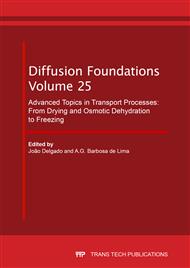[1]
B.A.A. Sousa, R. T. P. Correia, Biotechnological reuse of fruit residues as a rational strategy for agro-industrial resources. J Tech Manag. Innov., 5: 104-112. (2010).
Google Scholar
[2]
P.C. Pereira, A cultura do tamarindeiro (Tamarindus indica L.).Disponível em: <www.fruticultura.iciag.ufu.br/tamarindo.htm>. Acesso em: 11 set. (2016).
Google Scholar
[3]
P.C. Pereira, B. Melo, R.S. Freitas, M. A.Tomaz, C. J.P. Freitas,Tamarind seedlings produced under different levels of organic matter added to the substrate. Revista Verde de Agroecologia e Desenvolvimento Sustentável, Mossoró, v. 5, n. 3, pp.152-159, 2010.(In Portuguese).
Google Scholar
[4]
A.F.A. Ferreira, Propagação vegetativa de Tamarindus indica L. 96 f. 2014. Dissertação de Mestrado em Agronomia, UNESP, Ilha Solteira, São Paulo, (2014).
Google Scholar
[5]
J.C. Viveros, K.A. Figueroa, F. Gallardo, E. García, O. Ruiz, F. Hernández, Sistemas de manejo y comercialización de tamarindo (Tamarindus indica L.) entresmunicipios de Veracruz. Rev. Mex. Ciencias Agrícolas. México, (2012).
DOI: 10.29312/remexca.v3i6.1373
Google Scholar
[6]
E. De Caluw, K. Halamov, P. Van Damme, Tamarindus indica L.: a review of traditional uses, phytochemistry and pharmacology. Afrika Focus. 23(1): 53-83. (2010).
DOI: 10.1163/2031356x-02301006
Google Scholar
[7]
N. Razali, S. Mat-Junit, A.F. Abdul-Muthalib, S. Subramaniam, A. Abdul-Aziz, Effects of various solvents on the extraction of antioxidant phenolics from the leaves, seeds, veins and skins of Tamarindusindica L. Food Chemistry. United Kingdom. (2012).
DOI: 10.1016/j.foodchem.2011.09.001
Google Scholar
[8]
E.D. Azevedo, A. M. Alves, Engineeringseparation process. Lisboa: IST Press, 820 p.2013.(In Portuguese).
Google Scholar
[9]
C.E.M.R. Gurgel, Foam-mat of Graviola Pulp - Process Performance and Product Characteristics. BluchrChemicalEngineeringProceedings. 86 p.2014.(In Portuguese).
Google Scholar
[10]
A.P. Martinazzo, P. C. Corrêa, E. C. Melo, F. F. Barbosa, Effective diffusivity of Cymbopogon citratus (DC.) Stapf leaves submitted tothe drying process with different leaf length cuts and air temperature. Revista Brasileira de Plantas Medicinais, Botucatu, v. 9, n. 1, pp.68-72, 2007.(In Portuguese).
DOI: 10.1590/s1516-05722010000400013
Google Scholar
[11]
P.J. Fellows, Food processing technology: principles and practice. São Paulo: Editora Artmed, 602 p.2006.(In Portuguese).
Google Scholar
[12]
F. Castilho, G. G. Fontanari, J. P. Batistuti, Evaluation of some functional properties of lupin sweet flour (Lupinusalbus) and faba bean flour (Cajanuscajan (L) Millsp) and their utilization in cooked ham production. Ciência e Tecnologia de Alimentos, Campinas-SP, v. 30, n. 1, pp.68-75, 2010.(In Portuguese).
Google Scholar
[13]
S.B. Lopes, Utilization of the residue generated in the production of mini beets for the production of flour. Comunicado técnico Embrapa. 2011.(In Portuguese).
Google Scholar
[14]
ANVISA - BRASIL. Ministério da saúde. Agência Nacional de Vigilância Sanitária. Resolução Diretória Colegiada - RDC nº 263, de 22 de setembro de 2005. Regulamento técnico para produtos de cereais, amidos, farinhas e farelos.
DOI: 10.22239/2317-269x.01481
Google Scholar
[15]
M.L.R. Silveira, O. S. Santos, N. G. Penna, C. K. Sautter, C. S. Rosa, S. M. M. Bertagnolli, Aproveitamento tecnológico das sementes de goiaba (Psidiumguajava L.) como farinha na elaboração de biscoitos. Boletim CEPPA, Curitiba-PR, v. 34, n. 1, pp.1-21, (2016).
DOI: 10.5380/cep.v34i2.53178
Google Scholar
[16]
P.A. Castell, H.A. Váquirio, J.A. Cárcel, C. Rosselló, A. Femenia, S. Simal, Mathematical modeling of moisture distribution and kinetics in cheese drying. Drying Technology, v. 30, pp.1247-1255, (2012).
DOI: 10.1080/07373937.2012.704465
Google Scholar
[17]
F.C. Moraes filho, E. L. Oliveia, E. M. M. A. Nobrega, J. A. Oliveira, R. T. P. Correira, Convective drying of acerola (malphigia emarginata dc.): application of semi-theoretical models. Holos, v.01, pp.86-95, (2014).
DOI: 10.15628/holos.2014.970
Google Scholar
[18]
L.C.P. Almeida,Osmotic dehydration and convective drying of grapes(cultivar crimson). Dissertação (Mestrado em Engenharia de Alimentos) - Federal Universityof Santa Catarina, Florianópolis, Brazil, 2013. 105 f. (In Portuguese).
Google Scholar
[19]
M.A. Madrau, A. Sanguinetti, A. Del Caro, C. Fadda, A. Piga, Contribution of melanoidins to the antioxidant activity of prunes. Journal of Food Quality, v. 33, pp.155-170, (2010).
DOI: 10.1111/j.1745-4557.2010.00328.x
Google Scholar


